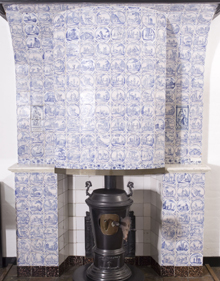The Tiles Collection > History of the Dutch tile
In the sixteenth century, Italian craftsmen migrated to the prosperous trading town of Antwerp, where they introduced the technique of decorating earthenware with tin glaze. For the first time, the people of the Low Countries became acquainted with the technique of painting earthenware in bright, shiny colors. The technique spread to the north and new workshops for tiles and majolica opened in a number of Dutch towns.
The demand for tiles increased substantially during the seventeenth century, when successful merchants and well-to-do citizens enlarged their houses and embellished them with impressive fireplaces. Tiles are heat-proof and easy to clean, which makes them highly suitable as a decoration for the rear wall of a fireplace. It was difficult to heat houses at the time, so tiles were also ideal for covering the damp walls. Demand increased with prosperity; tradesmen and farmers wanted decorated tiles too. Manufacturers stepped up their production and offered expensive, delicately painted single tiles and tableaus, as well as simple, affordable ornaments. Large quantities of tiles were exported to France, Germany, Russia, Spain, and the Ottoman Empire.
In the second half of the seventeenth century, the city of Delft became the center of production for high-quality tin glazed earthenware. The earthenware industry disappeared from most Dutch cities, though tile factories managed to survive in Rotterdam, Amsterdam, and Utrecht. Tile and plate production continued in the northern province of Friesland, more specifically in the towns of Harlingen and Makkum (and also for a time in Bolsward). The number of tile factories declined further during the second part of the eighteenth century: after 1860 the only old factories still in operation were those in Utrecht, Harlingen and Makkum.
Starting in 1880, the Dutch adopted modern industrial techniques that were already in use in England and Germany. The new tiles were harder and the palette was more diversified, allowing for a new range of uses. Tiles then gained architectural value by being used on facades and in doorways; shops used richly colored tiles as advertisements inside their premises. On the occasion of a firm's jubilee, the personnel often presented the management with a tableau to adorn the entrance to the offices. These tiles used to have ornamental edges bearing a dedication. Between 1890 and 1940, a great number of new ceramics factories were in operation which were also engaged in decorating tiles. The quality of the work was generally outstanding, but it was a labor-intensive process and the output was low in comparison with other countries.
In the course of the twentieth century, tiles were no longer put just to practical use, but they were often used exclusively as ornaments in their own right, sometimes in remembrance of a happy event, often the birth of a child, or bearing some wise adage.


